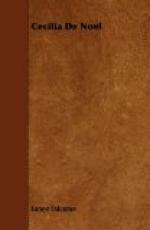“Certainly not; that is my own great-grand-aunt. I mean a square of black canvas with one round yellow spot in the middle and a dirty white smudge under the spot. There are members of this family—Aunt Eleanour, for instance—who tell me the yellow spot is a man’s face and the dirty white smudge is an Elizabethan ruff. Then there is a picture of a man in armour in the oak room, which I don’t believe is a portrait at all; but Aunt Henrietta swears it is, and of the ghost, too—as he was before he died, of course. And very interesting details both my aunts are ready to furnish concerning the two originals. It is extraordinary what an amount of information is always forthcoming about things of which nobody can know anything—as about the next world, for instance. The, last time I went to church the preacher gave as minute an account of what our post-mortem experiences were to be as if he had gone through it all himself several times.”
“Well, does the ghost usually appear in a ruff or in armour?”
“It depends entirely upon who sees it—a ghost always does. Last night, for instance, I lay you odds it wore neither ruff nor armour, because Mrs. Mallet is not likely to have heard of either the one or the other. Not that she saw the ghost—not she. What she saw was a bogie, not a ghost.”
“Why, what is the difference?”
“Immense! As big as that which separates the objective from the subjective. Any one can see a bogie. It is a real thing belonging to the external world. It may be a bright light, a white sheet, or a black shadow—always at night, you know, or at least in the dusk, when you are apt to be a little mixed in your observations. The best example of a bogie was Sir Walter Scott’s. It looked—in the twilight remember—exactly like Lord Byron, who had not long departed this life at the time Sir Walter saw it. Nine men out of ten would have gone off and sworn they had seen a ghost; why, religions have been founded on just such stuff: but Sir Walter, as sane a man as ever lived—though he did write poetry—kept his head clear and went up closer to his ghost, which proved on examination to be a waterproof.”
“A waterproof?”
“Or a railway rug—I forget which: the moral is the same.”
“Well, what is a ghost?”
“A ghost is nothing—an airy nothing manufactured by your own disordered senses of your own over-excited brain.”
“I beg to observe that I never saw a ghost in my life.”
“I am glad to hear it. It does you credit. If ever any one had an excuse for seeing a ghost it would be a man whose spine was jarred. But I meant nothing personal by the pronoun—only to give greater force to my remarks. The first person singular will do instead. The ghost belongs to the same lot, as the faces that make mouths at me when I have brain-fever, the reptiles that crawl about when I have an attack of the D.T., or—to take a more familiar example—the spots I see floating before my eyes when my liver is out of order. You will allow there is nothing supernatural in all that?”




